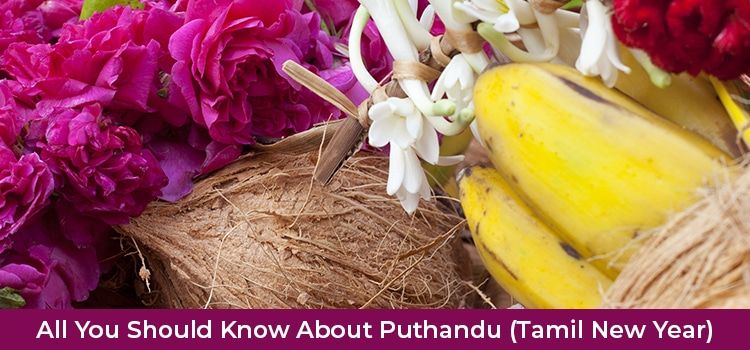Every New Year brings with it the promise of auspicious new beginnings. It is a time to make new plans and projects even as one bids goodbye to the old year. In Tamil Nadu, the New Year is called Puthandu, and it is celebrated as a festival in mid-April. To welcome the first day of the Tamil New Year or Vedic New Year, people take part in grand festivities and celebrations.
Tamil Puthandu falls on the first day of Chithirai month (mid-April- mid-May). It is usually celebrated on April 14. The New Year celebration takes place in other parts of India, too, as Vishu in Kerala and Baishakhi in northern and central India.
Origin of the Tamil New Year
The Tamil calendar follows a traditional 60-year cycle. Each year starts with the month of Chithirai. Tamil Puthandu follows the spring equinox, which is on April 14 in the Gregorian calendar. The importance of this day finds mention in Tamil literature.
In the 3rd century, Nakkirar said in his ancient poem, ‘Nedunalvaadai’, dating back to the Sangam era, that the movement of the Sun in the 12 zodiac signs, starting with Aries, occurs on this day. The oldest extant Tamil grammar text, Tolkaapiyam, divides the year into six separate seasons, and this day marks the beginning of the summer or Ilavenil season.
Kudalur Kizhaar, in the Purananuru, refers to Mesha Raasi/Chithirai as the beginning of the year. The Silappadikaaram talks about the 12 Rasis or Moon signs beginning with Mesha/Chithirai. The Manimekalai also mentions the Hindu solar calendar. Adiyarkunalaar, who was an early medieval commentator, refers to the 12 months of the Tamil calendar, especially Chithirai. The Tamil calendar is based on the solar system and the Rasi chakra.
Controversy Around Tamil Puthandu
In 2008, the DMK (Dravida Munnetra Kazhagam), which was in power in Tamil Nadu, declared that the Tamil New Year should be on the first day of the Tamil month of Thai (14 January). This made it coincide with Pongal, the Tamils’ harvest festival. It was enacted as a state law as well – the Tamil Nadu New Year (Declaration Bill 2008). But on 23 August 2011, the AIADMK government rescinded the law by bringing a separate act of legislation.
Despite the 2008 law, many Tamilians had continued to celebrate the Puthandu festival in mid-April. Hindu priests and Tamil scholars questioned the law, and many Tamils were against it. There were legal challenges too. For these reasons, perhaps, the AIADMK dispensation decided to revert to the April date. It also announced that Tamil Puthandu day would be celebrated as a new festival under the name, “Chithirai Tirunal”, or the festival of Chithirai.
Tamil Puthandu Celebration
People make elaborate preparations for the Puthandu celebrations. The first step is to clean the house thoroughly. The second step is to decorate the house. The third step is to prepare food items based on the concept of Arusuvai or a medley of tastes, including sweet, sour, salty, etc.
The day before the festival, people clean their houses and make them spick and span to mark a new beginning. This ritual of deep home cleaning on Tamil New Year’s eve is associated with the belief that one should get rid of the old to make room for the new. After cleaning the house, people also decorate it. They decorate the doorway with mango leaf thoranams (strings of freshly plucked mango leaves). Then they create colorful and intricate Kolams or rangolis with rice flour, in front of the house.
The Kani Ritual
An important custom that is part of the Puthandu celebration is the ritual of Kani, which means “auspicious sight.” Money, flowers, gold/silver jewelry, three fruits (mango, jackfruit, and banana), betel leaves, areca nuts, and a mirror are arranged on a tray. This is the Kani. The tray is arranged and kept in the Pooja room the previous night by the lady of the house. The next morning, everyone has to look at this Kani before they see anything else, once they wake up. Doing so is believed to bring auspiciousness and prosperity during the new year. The Kani is arranged to appease Goddess Lakshmi.
New Year Traditions
Early in the morning on Puthandu day, Tamilians awake and take a bath. Some, especially in the rural areas, also have a herbal bath with some turmeric.
After the bath, the entire family wears new clothes that have been specially bought for the occasion. Doing so is also a way to mark new beginnings.
After wearing their new outfits, all the family members pray and make offerings to the gods. They may do Poojas, chant Mantras, and offer Arathi. Many also visit temples and pray for an auspicious and prosperous Tamil New Year.
The elders in the family offer money or presents to children and younger family members. The head priest or eldest family member reads out aloud the Panchangam, a Hindu calendar and almanac.
New Year Dishes
One thing people look forward to during the Tamil Puthandu celebrations is the vegetarian feast that is specially prepared on the day. It includes many items, but the most relished item of this traditional feast is Mango Pachadi. Many flavors go into it, including sweet (jaggery), sour (raw mango), astringent (mustard), bitter (neem), and spice (red chillies). Other special Puthandu dishes include Dhal Poli and Veppam Poo Rasam. There is a symbolism behind this. The different flavors remind one that life is like the mango pachadi, full of diverse flavors or experiences – bitter, sad, sweet, sour, etc.









Comments & Discussion
3 COMMENTS
Please login to read members' comments and participate in the discussion.